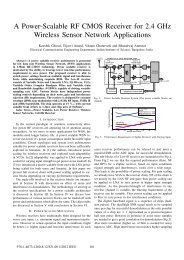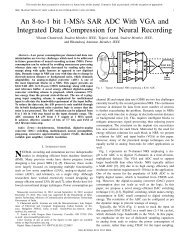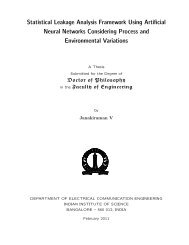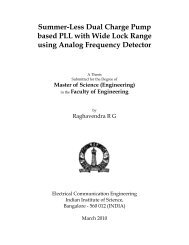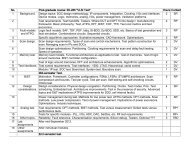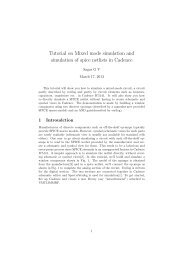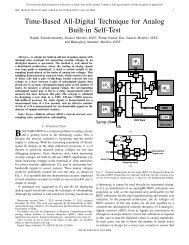NoC design and optimization for Multi-core media processors
NoC design and optimization for Multi-core media processors
NoC design and optimization for Multi-core media processors
You also want an ePaper? Increase the reach of your titles
YUMPU automatically turns print PDFs into web optimized ePapers that Google loves.
CHAPTER 2. RELATED WORK 23framework quantifies power consumption of all the major units of the processor, parameterizethem, <strong>and</strong> integrate these power estimates into a high-level simulator. Wattchmodels main processor units into array structures, fully associative content-addressablememories,combinational logic <strong>and</strong> wires or clocking elements. Individual capacitancesof each of these elements are estimated <strong>and</strong> power is calculated. Work presented in [95]integrates Wattch into SimpleScalar architectural simulator[96].A tool like Ruby[97], allows one to simulate a complete distributed memory hierarchywith an on-chip network as in Orion. However, it needs to be augmented with a detailedinterconnect model which accounts <strong>for</strong> the physical area of the tiles <strong>and</strong> their placements.Network Processor exploration <strong>and</strong> power estimation tools utilize models <strong>for</strong> smallercomponents <strong>and</strong> quote the integrated power <strong>for</strong> the system[98][99][100]. They use cycleaccurate register, cache <strong>and</strong> arbiter models introduced previously here. NePSim[99] isan open-source integrated simulation infrastructure. Typical network <strong>processors</strong> can besimulated with the cycle accurate simulator inclusive in the framework. Testing <strong>and</strong>validation of results can be per<strong>for</strong>med by an automatic verification framework. NePSimcombines various power models from Xcacti[101], Wattch[95] <strong>and</strong> Orion[71] <strong>for</strong> differenthardware structures in NePSim. XCacti[101] is an enhanced version of Cacti 2.0 thatincludes power modeling <strong>for</strong> cache writes, misses, <strong>and</strong> writebacks. NePSim classifies thenetwork processor components into categories such as ALU <strong>and</strong> shifter, registers, caches,queues <strong>and</strong> arbiters. The processor’s power consumption can be calculated using a power<strong>and</strong> an estimation tool inbuilt into the framework.SapphireThe tile area <strong>optimization</strong> problem is closely knit with interconnect, cache <strong>and</strong> processorarchitecture exploration. There is a need <strong>for</strong> a co-<strong>design</strong> of interconnects, processingelements <strong>and</strong> memory blocks to fully optimize the overall multi-<strong>core</strong> chip per<strong>for</strong>mance.This necessitates a simulation framework which allows a co-simulation of processor <strong>core</strong>s,a detailed cache memory hierarchy, on-chip network, along with a low-level interconnectmodel.




